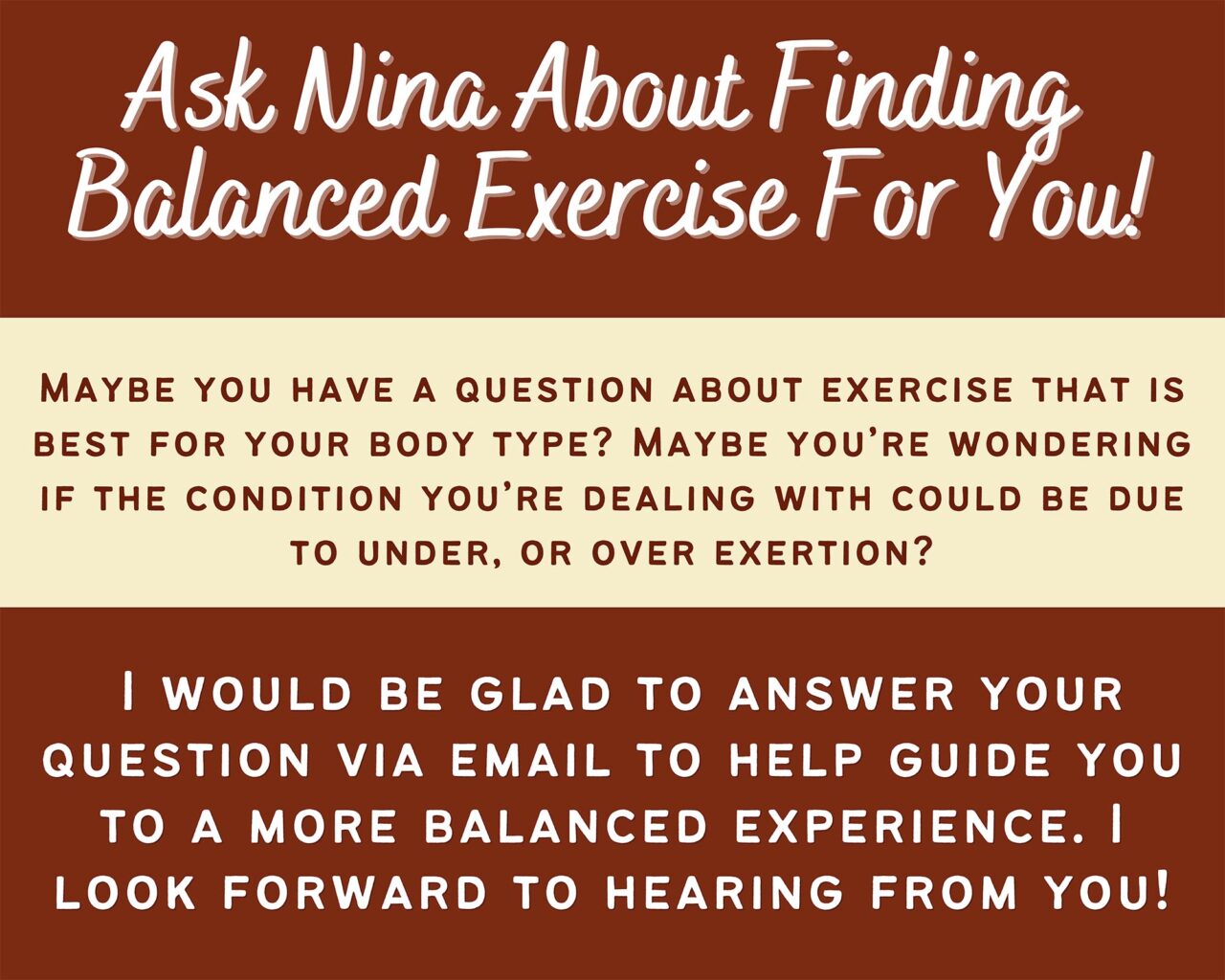I’m sure you don’t often hear that you may actually be healthier by not exercising. Well, in some cases there is truth to this— at least when it comes to some types of exercise, for some people, and at certain times.
Depending on the qualities of your physical makeup, there are certain “rules” of exercise you’ll want to follow in order to prevent the imbalance from either overdoing or underdoing the level of strain that’s right for your particular body.
As always, Ayurveda’s guidelines are for prevention of disease and preservation of good health, through balance among the energies, or ‘Doshas’ present within us.
Let’s start with the two big questions that you are probably wondering about…
One last thing before we get into this— I offer a free, easy service at the bottom of each of these newsletters, called “Ask Nina,” where I welcome you to contact me about any specific questions you have about your own experience with this topic.
Knowing WHO Should Exercise
Who Is Suitable for Exercise?
People who are strong. Exercise helps preserve that strength by toning muscles and enabling better blood flow.
People who indulge in fatty foods regularly. Kapha accompanies fat in the body, and exercise reduces the qualities inherent in Kapha. (More on those below)
People who spend a lot of time seated. Exercise creates movement and mobility in the body by introducing Vata, counteracting the effects of being stationary.
These People Should Exercise Regularly, at Half Their Capacity.
Signs of This Are: Need for mouth breathing, dryness in the mouth, increased perspiration on forehead, nose, armpits, shoulders & back.
For those who do not identify with these traits, simply doing mild exercise is appropriate.
Who Should Be Cautious with Vigorous Exercise?
Those Who are Suffering from Vata Disease
This includes women in their menstrual cycle or women who have delivered a baby within the last 40 days. The body is experiencing heightened Vata at this time due to movement within the body and does not need the extra Vata associated with exercise.
This also includes those with joint issues, such as gout or arthritis. Exercise will only exacerbate these conditions.
Those Suffering from Pitta Disease
This includes skin diseases, and bleeding diseases such as nose bleeds, bleeding gums, or excessive menstruation.
Aged People and Those with Indigestion Issues
An alternative type of exercise that is better for those who are weak or aged is taking a morning or evening walk.
Those With a Vata Constitution
Extra Vata from movement in the body associated with repairing tissue is not needed.
Instead, this type of person should focus on preservation, and handling themselves gently.
Those With a Pitta Constitution
Exercise heats up the body and in turn increases Pitta, which can cause imbalance.
These people should focus on preventing the body from overheating.
by exercising on alternate days and managing other activities such as proper sleep time.
What Are Signs of Overexertion?
Emaciation, excess thirst, difficulty breathing, feeling of debility without exertion, bleeding diseases, cough, fever, trouble falling asleep, or loss of sleep are some of the notable issues with overexertion from exercise.
Overexertion beyond your limits moves Vata to a point of extra aggravation, and into the tissues of the body.
Why Massage and Relaxation After Exercise?
Ayurveda highly recommends massage after vigorous exercise. Massage tones muscles after exertion. Relaxation like ‘Shavasana’ practice in yoga is also recommended to bring the body back to homeostasis after vigorous exercise.
Knowing WHEN to Exercise
Above we covered WHO exercise is, and isn’t best for. But there is also the matter of WHEN in a proper exercise regimen…
What is the Best Time in the Day to Exercise?
Early morning time (between 6 am – 10 am) is the best time to exercise because this is when the Kapha Dosha is most present in the day. This Kapha Dosha has earth and water elements and is heavy and dense along with them.
Exercise brings the opposite effect of lightness, agility, and reduction in fat tissue that is predominant with Kapha.
When Should We Be Cautious About Exercising?
Never exercise right after a big meal.
Exercising when you are very hungry is ill-advised as Vata is already elevated at that point, and exercise raises Vata.
Nighttime is not a good time for exercise as it would disturb the natural rhythm of the body that is in process of winding down at this time in the day.
When is the Best Time of Year to Exercise?
Spring and winter seasons are the most appropriate seasons for vigorous exercise. The cold of Winter has a cooling and constricting effect on skin, lungs, and body resulting from a lower temperature.
Physical exercise is essential at this time as it generates heat.
Excess moisture in the air in Spring naturally increases Kapha, as Kapha is composed of water and earth elements.
Exercise is needed to counteract the excess heaviness and sluggishness from Kapha during this time of year
What Time of Year Should We Be Careful with Exercise?
Fall and Summer, especially Summer, is when one is advised to stick to mild exercise. This prevents the sun and summer heat from over-depleting our bodies and allows us to preserve energy. Enjoy the sun, but don’t let it deplete you!


